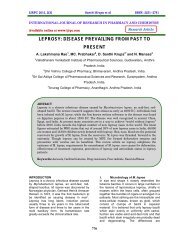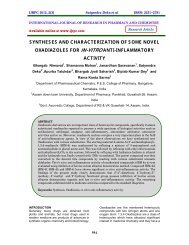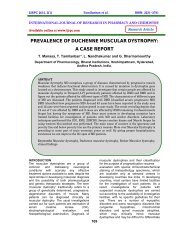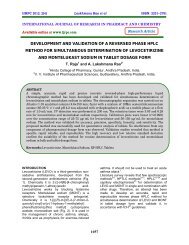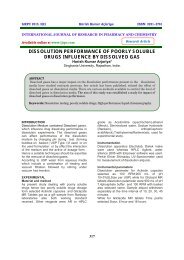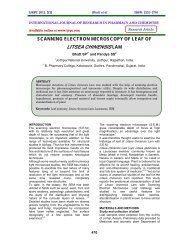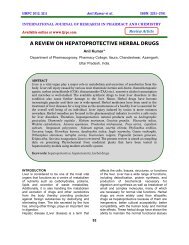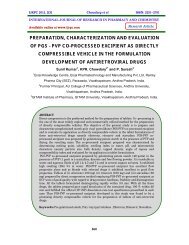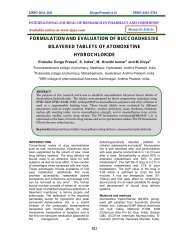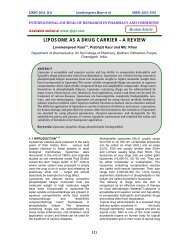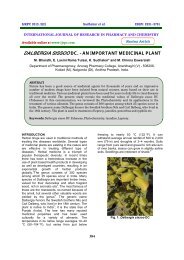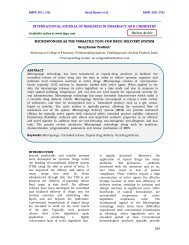formulation and development ofcontrolled release ... - ijrpc
formulation and development ofcontrolled release ... - ijrpc
formulation and development ofcontrolled release ... - ijrpc
Create successful ePaper yourself
Turn your PDF publications into a flip-book with our unique Google optimized e-Paper software.
IJRPC 2012, 2(3) Ahuja Naresh et al ISSN: 22312781<br />
INTERNATIONAL JOURNAL OF RESEARCH IN PHARMACY AND CHEMISTRY<br />
Available online at www.<strong>ijrpc</strong>.com<br />
Research Article<br />
FORMULATION AND DEVELOPMENT OF CONTROLLED<br />
RELEASE MULTIPARTICULATE TABLETS USING BLENDS<br />
OF VARIOUS NATURAL GUM<br />
Ahuja Naresh 1 * <strong>and</strong> Bh<strong>and</strong>ari Anil 2 , Devendra Yadav, Atul Garg <strong>and</strong> Sanjay Khanna<br />
1 Department of Pharmaceutics Bharti Institute of Pharmaceutical Sciences, Sri Ganganagar,<br />
Rajasthan, India.<br />
2 Department of Pharmaceutics Jodhpur National University. Jodhpur, Rajasthan, India.<br />
ABSTRACT<br />
PURPOSE: The objective of the present study is to develop colon targeted drug delivery<br />
systems for sennosides using guar gum as a carrier. METHODS: Matrix tablets containing<br />
various proportions of guar gum were prepared by wet granulation technique using starch<br />
paste as a binder. The tablets were evaluated for content uniformity <strong>and</strong> in vitro drug <strong>release</strong><br />
study as per BP method. T50 % value from the dissolution studies was taken for selecting the<br />
best <strong>formulation</strong>. RESULTS: Guar gum matrix tablets <strong>release</strong>d 4-18% sennosides in the<br />
physiological environment of gastrointestinal tract depending on the proportion of the guar<br />
gum used in the <strong>formulation</strong>. The matrix tablets containing 50% of guar gum were found to be<br />
suitable for targeting of sennosides for local action in the colon. Compared to tablets having<br />
30% <strong>and</strong> 40% of guar gum, those with 50% guar gum gave better T 50% (11.7 h) <strong>and</strong> fewer<br />
amounts (5-8%) of drug <strong>release</strong> in upper GIT. These tablets with 50% guar gum <strong>release</strong>d 43%<br />
<strong>and</strong> 96% sennosides with <strong>and</strong> without rat caecal fluids. This suggests the susceptibility of<br />
matrix to the colonic micro flora. The similarity factor ( f 2 value) for drug <strong>release</strong> with <strong>and</strong><br />
without rat caecal fluids was found to be less than 30. When hydroxy propyl methylcellulose<br />
phthalate (10%) was used as a coat material on the matrix tablets, the initial loss of 5-8%<br />
sennosides in stomach could be completely averted. These tablets showed no change in<br />
physical appearance, content <strong>and</strong> dissolution profile upon storage at 45°C / 75% relative<br />
humidity for 3 months. CONCLUSION: The results of our study indicates that matrix tablets<br />
containing 50% guar gum <strong>and</strong> coated with 10% hydroxy propyl methylcellulose phthalate are<br />
most suitable for drugs like sennosides which are mainly active in the lower GIT.<br />
Keywords: Matrix Tablet, Guar gum, Multiparticulate.<br />
INTRODUCTION<br />
Several polysaccharides like, pectin <strong>and</strong> its<br />
salts, chondroitin sulphate, amylose <strong>and</strong> guar<br />
gum are being investigated as carriers for<br />
colon specific drug delivery. In pharmaceutical<br />
<strong>formulation</strong>s, guar gum is used as a binder,<br />
disintegrant, suspending agent, thickening<br />
agent <strong>and</strong> stabilizing agent. (1,2) Guar gum <strong>and</strong><br />
pectin are reported to be potential carriers for<br />
colon specific drug delivery. Colon specific<br />
drug delivery systems for 5-ASA <strong>and</strong><br />
mebendazol have been developed using guar<br />
gum as a carrier (3,4). Guar gum in the form<br />
either of a matrix tablet or as a compression<br />
coat over a core tablet of drug is reported to<br />
target the drug to colon (5-9) . The guar gum<br />
matrix tablets of albendazole were found<br />
degraded by colonic bacteria of rat caecal<br />
contents <strong>and</strong> <strong>release</strong>d about 44% of<br />
albendazole in simulated colonic fluids (control<br />
study) at the end of 24 h indicating the<br />
susceptibility of the guar gum <strong>formulation</strong>s to<br />
the rat caecal contents. Compression coated<br />
tablets of 5-ASA <strong>and</strong> matrix tablets of<br />
560
IJRPC 2012, 2(3) Ahuja Naresh et al ISSN: 22312781<br />
mebendazole have been prepared using guar<br />
gum as a carrier. Matrix tablets containing<br />
various proportions of guar gum were<br />
prepared by wet granulation technique using<br />
starch paste as a binder. The tablets were<br />
evaluated for drug content uniformity, <strong>and</strong><br />
were subjected to in vitro drug <strong>release</strong> studies.<br />
The results of the study revealed that matrix<br />
tablets containing either 20% or 30% of guar<br />
gum are most likely to provide targeting of<br />
mebendazole for local action in the colon. A<br />
novel colon-specific drug delivery system<br />
based on guar gum matrix tablets was<br />
evaluated by conducting gamma scintigraphy<br />
studies using technitium-99m-DTPA as a<br />
tracer, in six healthy male human volunteers.<br />
Scintigraphs taken at regular intervals showed<br />
that some amount of tracer present on the<br />
surface of the tablets was <strong>release</strong>d in stomach<br />
<strong>and</strong> small intestine <strong>and</strong> the bulk of the tracer<br />
present in the tablet mass delivered to the<br />
colon. These studies have shown the drug<br />
<strong>release</strong> retarding property of guar gum in the<br />
upper GIT <strong>and</strong> its degradation by the<br />
anaerobic bacteria in the colon (10-11).<br />
Senna is a well-known drug in Ayurvedic<br />
system of medicine <strong>and</strong> has been included in<br />
most of the pharmacopoeias of the world. In<br />
India, this drug is known as Tinnevelly Senna,<br />
family Leguminoseae. The active constituents'<br />
sennosides A <strong>and</strong> B are of medicinal interest<br />
due to their strong laxative properties. The<br />
action of sennosides is mainly upon the large<br />
intestine <strong>and</strong> is, therefore, especially suitable<br />
in habitual constipation. The glycosides are<br />
absorbed from the intestinal tract <strong>and</strong> the<br />
active anthraquinones are excreted into the<br />
colon, where they stimulate <strong>and</strong> increase the<br />
peristaltic movements of the colon, decrease<br />
absorption of water from colon <strong>and</strong> produce a<br />
bulky softer fecal mass. This suggests their<br />
action is in lower bowel <strong>and</strong> have no effect in<br />
stomach <strong>and</strong> small intestine (12-14).<br />
In the light of this information, it is planned to<br />
develop novel sennosides matrix tablets for<br />
colon targeting to provide effective safe<br />
therapy of laxation.<br />
EXPERIMENTAL<br />
MATERIALS<br />
Calcium sennosides (20%w/w) was gifted by<br />
Dishman Pharmaceuticals, Ahmedabad, India.<br />
Guar gum (viscosity of 1% aqueous dispersion<br />
is 4000 cps, particle size < 75 was obtained<br />
from H.B. Gum industries, Kalol, Gujarat,<br />
India, <strong>and</strong> was of pharmacopoeial grade<br />
(USNF). Ferric chlorides (AR), sodium<br />
bicarbonate (AR), chloroform, hydrochloric<br />
acid, magnesium acetate <strong>and</strong> solvent ether<br />
were obtained from S.D. fine Chemicals,<br />
Mumbai, India. Double distilled water (DD<br />
water) was used. Other materials in the study<br />
such as microcrystalline cellulose (Avicel PH<br />
101), starch, magnesium stearate <strong>and</strong> talc<br />
were of pharmacopoeial grade.<br />
Preparation of sennosides matrix tablets<br />
Matrix tablets of calcium sennosides were<br />
prepared by wet granulation method.<br />
Microcrystalline cellulose (MCC) was used as<br />
a diluent <strong>and</strong> compression promoting agent<br />
<strong>and</strong> a mixture of talc- magnesium stearate<br />
(2:1) was added as lubricant. Guar gum was<br />
included in the <strong>formulation</strong>s in various<br />
proportions (30%-70%). The composition of<br />
different <strong>formulation</strong>s used in the study<br />
containing 100 mg of calcium sennosides<br />
(20%w/w) in each <strong>formulation</strong> is shown in<br />
Table no.-1.<br />
Table 1: Composition <strong>and</strong> characteristics of calcium sennosides matrix tablets<br />
561
IJRPC 2012, 2(3) Ahuja Naresh et al ISSN: 22312781<br />
In all the <strong>formulation</strong>s, guar gum was sieved<br />
separately <strong>and</strong> mixed with calcium sennosides<br />
<strong>and</strong> MCC. The powders were blended <strong>and</strong><br />
granulated with 10%w/v starch paste. The wet<br />
mass was passed through a mesh (10#) <strong>and</strong><br />
the granules were dried at 60°C for 1 h. The<br />
dried granules were passed through a mesh<br />
(20#), lubricated with a mixture of talcmagnesium<br />
stearate (2:1) <strong>and</strong> compressed<br />
using 12 mm round, concave <strong>and</strong> plain<br />
punches on a Rotary tablet press (Cadmach,<br />
India). The tablets were evaluated for their<br />
physical characteristics as per st<strong>and</strong>ard<br />
methods. The crushing strength <strong>and</strong> friability<br />
of matrix tablets was determined by Pfizer<br />
Hardness tester <strong>and</strong> Roche Friabilitor<br />
respectively.<br />
Determination of drug content in tablet<br />
<strong>formulation</strong>s<br />
Sennosides were analyzed by British<br />
pharmacopoeial (BP) method. Ten tablets<br />
were finely powdered <strong>and</strong> transferred to 100<br />
ml volumetric flask. Initially about 50 ml of<br />
double distilled water was added to the<br />
volumetric flask <strong>and</strong> allowed to st<strong>and</strong> for 1 h<br />
with intermittent sonication, volume was made<br />
up to 100ml with double distilled water, <strong>and</strong><br />
the mixture was centrifuged. Ten ml of<br />
supernatant liquid was taken for further<br />
analysis of sennosides as per BP method. Ten<br />
ml of the supernatant liquid transferred to 100<br />
ml round bottomed flask fitted with ground<br />
glass stopper. Twenty ml ferric chloride<br />
solution (10.5%w/v) was added <strong>and</strong> mixed. It<br />
was then heated in a water bath under reflux<br />
condenser for 20 min. one ml hydrochloric acid<br />
was added <strong>and</strong> heating was continued for 20<br />
min, with frequent shaking until the precipitate<br />
is dissolved. Mixture was cooled <strong>and</strong> extracted<br />
with 100ml (25 ml X 4) ether. Ten ml ether<br />
extract was evaporated carefully to dryness<br />
<strong>and</strong> dissolved the residue in 10.0 ml of a 0.5%<br />
w/v solution of magnesium acetate in<br />
methanol. Absorbance of the resulting solution<br />
was measured at the maximum at about<br />
515nm, using methanol as the blank. Content<br />
of sennosides B was calculated.<br />
In-Vitro drug <strong>release</strong> studies<br />
The ability of guar gum matrix tablets of<br />
sennosides to remain intact in the<br />
physiological environment of stomach <strong>and</strong><br />
small intestine was assessed by mimicking<br />
mouth to colon transit. Drug <strong>release</strong> studies<br />
were carried out using USP XXIII dissolution<br />
apparatus (Apparatus 1, 100 rpm, 37± 0.5°C)<br />
in 900 ml 0.1 N HCl for 2 h as the average<br />
gastric emptying time is ~2 h.. The dissolution<br />
medium was replaced with 900 ml pH 7.4<br />
phosphate buffer saline (PBS) <strong>and</strong> the<br />
dissolution was continued for 24 h. Ten ml of<br />
the sample was taken at the end of the<br />
specified time period (2 h, 5 h, 8 h, 12 h, 16 h,<br />
18 h <strong>and</strong> 24 h) <strong>and</strong> analyzed for sennosides. A<br />
10 ml volume of filtered, fresh dissolution<br />
medium was added to make the volume after<br />
each sample withdrawal (15).<br />
The susceptibility of the matrix tablets to the<br />
enzymatic action of colonic bacteria was<br />
assessed by continuing the drug <strong>release</strong><br />
studies in simulated colonic fluids prepared<br />
using rat caceal content as described by Sinha<br />
et al. (16).<br />
Preparation of rat caecal content medium<br />
Wistar rat weighing 150-200 g <strong>and</strong> maintained<br />
on a normal diet (soaked gram) were used.<br />
Forty-five minutes before the commencement<br />
of drug <strong>release</strong> studies, seven rats were killed<br />
by spinal traction. The abdomen were opened,<br />
the cecal were traced, ligated at both the ends,<br />
dissected, <strong>and</strong> immediately transferred into pH<br />
7.4 buffer previously bubbled with nitrogen.<br />
The cecal bags were opened, their contents<br />
were individually weighed, pooled, <strong>and</strong><br />
suspended in the buffer continuously bubbled<br />
with carbon dioxide. These were finally added<br />
to the dissolution media to give a final cecal<br />
dilution of 4% w/v, respectively. All the above<br />
procedures were carried out under carbon<br />
dioxide in order to maintain anaerobic<br />
conditions.<br />
The drug <strong>release</strong> studies were continued with<br />
500 ml of rat caecal content medium (4%). A<br />
continuous supply of CO 2 was ensured, as the<br />
caecum is naturally anaerobic. At specified<br />
time intervals, 10 ml of the sample was<br />
withdrawn, filtered <strong>and</strong> replaced with 10 ml of<br />
fresh PBS containing 4% w/v rat ceacal fluids,<br />
bubbled with CO 2 , <strong>and</strong> the experiment was<br />
continued for 24 h as the usual colonic transit<br />
time is 20-30 h. Three sample samples for<br />
each data point were analyzed for sennoside<br />
content using BP method.<br />
Optimized batch was enteric coated with 10%<br />
w/v solution of hydroxy propyl methylcellulose<br />
phthalate (HPMCP) in order to retard the loss<br />
of sennosides in stomach. Weight gain of the<br />
coated tablet was found to be 6.7 %.<br />
Dissolution study was carried out for the<br />
coated tablets with <strong>and</strong> without colonic fluids.<br />
Stability studies<br />
To assess the stability of sennosides matrix<br />
tablets, tablets of batch G3 were stored at<br />
40°/75% RH for 3 months. At the end of the<br />
study period, the <strong>formulation</strong> was observed for<br />
changes in physical appearance, color, drug<br />
content <strong>and</strong> drug <strong>release</strong> characteristics. Drug<br />
562
IJRPC 2012, 2(3) Ahuja Naresh et al ISSN: 22312781<br />
<strong>release</strong> studies in rat caecal content medium<br />
were also carried out on sennosides matrix<br />
tablets of batch G3 after storage at 45°/75%<br />
RH for 3 months (17).<br />
Statistical analysis<br />
The drug <strong>release</strong> profiles of guar gum matrix<br />
tablets containing sennosides (n=3) in the<br />
dissolution medium at 24 h with <strong>and</strong> without<br />
rat caecal fluids (Control study) was compared<br />
using USP dissolution specification, f 2 value, a<br />
similarity factor (18). A value less than 30 was<br />
considered significant value indicating<br />
dissimilarity in dissolution profiles. Drug<br />
<strong>release</strong> kinetics was also studied for all matrix<br />
<strong>formulation</strong>s.<br />
RESULTS AND DISCUSSION<br />
The present study was aimed at developing<br />
novel matrix tablet of sennosides for colon<br />
targeting using guar gum as a matrixing agent.<br />
Guar gum matrix tablets <strong>release</strong>d decreased<br />
amount of sennoside in the physiological<br />
environment of stomach <strong>and</strong> small intestine.<br />
Majority of drug was <strong>release</strong>d in the<br />
physiological environment of colon.<br />
Since guar gum is found to have poor flow<br />
characteristics <strong>and</strong> is to be incorporated in<br />
large amount in matrix tablets, sennoside<br />
tablets were prepared by wet granulation<br />
technique using starch paste as a binder. The<br />
small samples of powder mixture of guar gum<br />
<strong>and</strong> sennoside drawn r<strong>and</strong>omly were analyzed<br />
for assessing uniformity of mixing. The<br />
crushing strength of the tablet was found to be<br />
4.7 kgf to 5.3 kgf (Table 1). The matrix tablets<br />
were found to contain 98.83% to 103.8% of<br />
the sennosides in each batch.<br />
The matrix tablets were subjected to in-vitro<br />
drug <strong>release</strong> study in 0.1 M HCl (2 h), pH 7.4<br />
PBS (3 h) <strong>and</strong> simulated colonic fluids (rat<br />
caecal content medium at 4% w/v level after 7<br />
days of enzyme induction). It is reported that<br />
rat caecal content medium at the 4% w/v level<br />
after 7 days of enzyme induction provides a<br />
satisfactory condition for assessing the<br />
susceptibility of guar gum to colonic bacterial<br />
degradation (16).<br />
Dissolution studies were extended up to 24 h<br />
wherever necessary. When the matrix tablets<br />
were subjected to in-vitro drug <strong>release</strong> study,<br />
sennoside tablets containing 30 % of guar<br />
gum (G1) <strong>release</strong>d 18% sennosides in first 2 h<br />
<strong>and</strong> most of the sennoside was <strong>release</strong>d within<br />
12 h with complete erosion of tablet. This<br />
might be due to lower guar gum content <strong>and</strong><br />
higher quantity of MCC in matrix tablet (Table<br />
1). The dissolution study was conducted<br />
without rat caecal content in dissolution<br />
medium (control). Sennosides tablets<br />
containing 40-60% of guar gum (G2-G5)<br />
showed better results compared to batch G1<br />
(30% guar gum). shown in Figure -1 .<br />
Fig. 1: Percent sennosides <strong>release</strong>d from matrix tablets containing<br />
G1 (30% guar gum) in dissolution study with <strong>and</strong> without rat ceacal content<br />
In control study batch G1 showed 70%<br />
cumulative percent <strong>release</strong> of sennoside at the<br />
end of 24 h. Tablet remained intact during<br />
control study but showed very loose gel.<br />
Matrix tablets containing 40% guar gum (G2)<br />
remain intact until 20 h. The amount of<br />
sennoside <strong>release</strong>d from G2 matrix tablets at<br />
the end of 18 h was found to be 97 ± 1.32 %<br />
whereas in control study (without rat ceacal<br />
content in dissolution medium) only 53.01 ±<br />
1.06 % of sennoside was <strong>release</strong>d even after<br />
24 h. (fig-2).<br />
563
IJRPC 2012, 2(3) Ahuja Naresh et al ISSN: 22312781<br />
Fig. 2: Percent sennosides <strong>release</strong>d from matrix tablets containing<br />
G2 (40% guar gum) in dissolution study with <strong>and</strong> without rat ceacal content<br />
On exposure to the dissolution fluids, the guar<br />
gum is hydrated <strong>and</strong> forms a viscous gel layer<br />
that slows down further entry of dissolution<br />
fluids towards the core of tablets. The<br />
hydration of guar gum is independent of the<br />
pH of the dissolution medium (19). The study<br />
shows that the <strong>release</strong> of sennosides in the<br />
physiological environment of colon is due to<br />
the microbial degradation of guar gum matrix<br />
tablets in the presence of rat ceacal content.<br />
Similar observation was also noted by<br />
increasing the amount of guar gum in the<br />
matrix tablets, the <strong>release</strong> of sennosides<br />
decreased at the end of 24 h of dissolution<br />
study. Tablets of G3 (50% guar gum) <strong>release</strong>d<br />
about 96 ± 1.12 % of sennoside in the<br />
presence of rat caecal content as against 43 ±<br />
0.97 % of sennoside in control study (fig-3).<br />
Fig. 3: Percent sennosides <strong>release</strong>d from matrix tablets containing<br />
G3 (50% guar gum) in dissolution study with <strong>and</strong> without rat ceacal content<br />
A significant difference was noted in <strong>release</strong><br />
data obtained with <strong>and</strong> without rat ceacal<br />
content. The matrix tablets containing 60% of<br />
guar gum (G4) <strong>release</strong>d only 73.19 ± 1.32 %<br />
of sennoside in rat ceacal content medium at<br />
the end of 24 h whereas in control study it was<br />
only 32.54 ± 0.89 % (fig-4).<br />
564
IJRPC 2012, 2(3) Ahuja Naresh et al ISSN: 22312781<br />
Fig. 4: Percent sennosides <strong>release</strong>d from matrix tablets containing<br />
G4 (60% guar gum) in dissolution study with <strong>and</strong> without rat ceacal content<br />
Batch G5 (70% guar gum) showed 43.57± 1.0<br />
% <strong>and</strong> 21.08 ± 0.94 % drug <strong>release</strong> at the end<br />
of 24h, with <strong>and</strong> without colonic fluids<br />
respectively (fig-5). The results show that G3<br />
<strong>and</strong> G4 <strong>formulation</strong>s were degrading slowly in<br />
simulated colonic fluids indicating that 50%<br />
<strong>and</strong> 60% of guar gum in the matrix <strong>formulation</strong><br />
is good enough for the colonic enzyme to act<br />
upon the <strong>formulation</strong> <strong>and</strong> degrade it. On<br />
further increasing the proportion of guar gum<br />
from 60 to 70%, a significant decline in the<br />
percent of drug <strong>release</strong> was noticed (73% <strong>and</strong><br />
43% for G4 <strong>and</strong> G5 respectively).<br />
Fig. 5: Percent sennosides <strong>release</strong>d from matrix tablets containing<br />
G5 (70% guar gum) in dissolution study with <strong>and</strong> without rat ceacal content<br />
The gel strength of the swollen matrix<br />
<strong>formulation</strong> might be too high to <strong>release</strong> the<br />
drug from the <strong>formulation</strong>. The action of<br />
colonic bacteria was not sufficient to degrade<br />
such a high strength gel barrier of the swollen<br />
G5 matrix <strong>formulation</strong>. Applying an enteric<br />
coat to the matrix tablets of guar gum could<br />
retard the initial loss of sennosides, releasing<br />
major portion of drug in colon. Batch G3<br />
<strong>release</strong>d almost 8% of sennosides in<br />
physiological environment of stomach; this<br />
could be further retarded by giving an enteric<br />
coat with 10% w/v HPMCP to the matrix<br />
tablets. (fig-6).<br />
565
IJRPC 2012, 2(3) Ahuja Naresh et al ISSN: 22312781<br />
Fig. 6: Comparison of percent sennosides <strong>release</strong>d from uncoated <strong>and</strong><br />
enteric coated matrix tablet of batch G3<br />
Dissolution data of batch G3, a potential<br />
c<strong>and</strong>idate for 24 h drug <strong>release</strong>, fitted best to<br />
zero order <strong>release</strong> kinetics, giving the least<br />
residual sum of square as compared to<br />
Weibull model or Korsemeyer <strong>and</strong> Peppas<br />
equation. (Table-2) (20-24).<br />
Table 2: Results of model fitting of batch G3 (with rat caecal<br />
content)<br />
566
IJRPC 2012, 2(3) Ahuja Naresh et al ISSN: 22312781<br />
Tablets from batch G3 could target sennosides<br />
in physiological environment of colon. Stability<br />
studies were carried out at 45°c / 75%RH for 3<br />
months to assess their stability. After storage,<br />
the tablets were subjected to assay of drug<br />
<strong>and</strong> in-vitro dissolution study. No changes in<br />
physical appearance, drug content <strong>and</strong><br />
dissolution profiles were noted. When<br />
dissolution study was carried out in<br />
physiological environment of stomach, small<br />
intestine <strong>and</strong> colon, no significant difference<br />
was observed in cumulative percent <strong>release</strong> of<br />
sennosides from <strong>formulation</strong> (Table-3).<br />
Table 3: Percent of sennoside <strong>release</strong>d from G3 matrix <strong>formulation</strong> before <strong>and</strong> after storage at<br />
45°c / 75%rh for 3 months<br />
These data suggest the <strong>formulation</strong> of G3 to be stable.<br />
CONCLUSIONS<br />
567
IJRPC 2012, 2(3) Ahuja Naresh et al ISSN: 22312781<br />
The present study was carried out to develop<br />
colon-targeted delivery system for sennosides<br />
using guar gum as a carrier. Guar gum matrix<br />
tablet containing various proportions of guar<br />
gum were prepared <strong>and</strong> subjected to in vitro<br />
drug <strong>release</strong> studies. Sennoside matrix tablets<br />
containing 30 % of guar gum are not suitable<br />
for colon targeting as they <strong>release</strong>d most of<br />
the drug within 10 h. In addition, matrix tablets<br />
containing 60% of guar gum are considered<br />
unsuitable for colon targeting as they <strong>release</strong>d<br />
only 73% of sennoside after 24 h of dissolution<br />
study. Tablets containing 40% <strong>and</strong> 50% of<br />
guar gum completely degraded in the<br />
presence of rat ceacal contents thereby<br />
releasing almost all the sennosides. Batch G3<br />
containing 50% guar gum <strong>release</strong>d entire drug<br />
in colon by zero order kinetics. The optimized<br />
batch, after storing at 45°c / 75%RH for 3<br />
months, showed no change in physical<br />
appearance, drug content or dissolution<br />
pattern.<br />
REFERENCES<br />
1. Latchman L, Lieberman HA <strong>and</strong> Kanig<br />
JL. The Theory <strong>and</strong> Practice of<br />
Industrial Pharmacy. 3 rd Indian edition,<br />
Varghese Publishers, India, 1990.<br />
592.<br />
2. Goldstein AM, Alter EN <strong>and</strong> Seaman<br />
JK. Guar Gum. In: Whistler RL (Ed).<br />
Industrial Gums, Polysaccharides <strong>and</strong><br />
their derivatives. Academic Press,<br />
New York, 1993;303-321.<br />
3. Krishnaiah YSR, Satyanarayan S <strong>and</strong><br />
Rama Prasad YV. Studies of guar<br />
gum compression coated 5-<br />
aminosalicylic acid tablets for colonspecific<br />
drug delivery. Drug Dev Ind<br />
Pharm. 1999;25:651-657.<br />
4. Krishnaiah YSR, Raju PV, Kumar BD,<br />
Bhaskar P <strong>and</strong> Satyanarayan V.<br />
Development of colon targeted drug<br />
delivery systems for mebendazole. J<br />
Control <strong>release</strong>. 2001;77: 87-95.<br />
5. Krishnaiah YSR, Muzib YI, Shrinivasa<br />
Rao G, Bhaskar P <strong>and</strong> Satyanarayana<br />
V. Design <strong>and</strong> In Vitro Evaluation of<br />
oral colon Targeted Drug Delivery<br />
system for Tinidazole. Journal of Drug<br />
Targeting. 2002;10(8):579-584.<br />
6. Krishnaiah YSR, Satyanarayana V,<br />
Seetha Devi A, Nageswar rao L,<br />
Bhaskar P, <strong>and</strong> Karthikeyan RRS.<br />
Guar Gum as a Carrier for colon<br />
specific delivery; Influence of<br />
Metronidazole <strong>and</strong> Tinidazole on In<br />
Vitro <strong>release</strong> of Albendazole from<br />
Guar gum Matrix tablets. J Pharm<br />
Pharmaceui Sci. 2001; 4(3):235-243.<br />
7. Rama Prasad YV, Krishnaiah YSR<br />
<strong>and</strong> Satyanarayana S. In vitro<br />
evaluation of guar gum as a carrier for<br />
colon-specific drug delivery. J Control<br />
Re. 1998;51:281-287.<br />
8. Krishnaiah YSR, Satyanarayana S,<br />
Rama Prasad YV <strong>and</strong> Narasimha Rao<br />
S. Gamma scintigraphic studies on<br />
guar gum matrix tablets for colonic<br />
drug delivery in healthy subjects. J<br />
Control Rel, 1988;55: 245-252.<br />
9. Krishnaiah YSR, Satyanarayana S,<br />
Rama Prasad YV <strong>and</strong> Narasimha Rao<br />
S. Evaluation of guar gum as a<br />
compression coat for drug targeting to<br />
colon. Int J Pharm. 1998;171:137-146.<br />
10. Simon GL <strong>and</strong> Gorbach SL. Intestinal<br />
flora in health <strong>and</strong> disease,<br />
Gastroenterology, 1984;86:174-193,.<br />
11. Macfarlane GT, Hay S, Macfarlane S<br />
<strong>and</strong> Gibson GR. Effect of different<br />
carbohydrates on growth,<br />
polysaccharidase <strong>and</strong> glycosidase<br />
production of Bacteroides ovatus in<br />
batch <strong>and</strong> continuos culture. J Appl<br />
Bacteriol. 1990;68:179-187.<br />
12. Leng-Peschlow E. Dual effect of orally<br />
administered Sennosides on large<br />
intestine transit <strong>and</strong> fluid absorption in<br />
the rat. J Pharm parmacol. 1986;38:<br />
606-610.<br />
13. British Pharmacopoeia, HMSO,<br />
London, UK, 1993.<br />
14. Martindale: the extra Pharmacopoeia,<br />
32 nd ed. Pharmaceutical Press,<br />
London, UK.<br />
15. United States Pharmacopoeial<br />
Convention (USP). 1999, USP 24-NF-<br />
19, Rockwille, USA.<br />
16. Sinha VR, Mittal BR <strong>and</strong> Bhutani KK.<br />
Rachna Kumari, Colonic drug delivery<br />
of 5-fluorouracil: an in vitro evaluation.<br />
Int J Pharm. 2004;269:101-108.<br />
17. . Carstesen JT. Drug Stability:<br />
Principle <strong>and</strong> Practices, 2 nd ed, Marcel<br />
Dekker, Inc., New York, 1995.<br />
18. Guidance for Industry, Dissolution<br />
Testing of Immediate <strong>release</strong> Solid<br />
oral Dosage Forms, U. S. Health <strong>and</strong><br />
Human Services, Food <strong>and</strong> Drug<br />
Administration, CDER, 1997.<br />
19. Gohel MC, Amin A, Panchal MK,<br />
Momin M, Bajaj S <strong>and</strong> Lalwani A.<br />
Preliminary investigations in matrix<br />
based tablet <strong>formulation</strong>s of diclofenac<br />
sodium containing succinic acid<br />
treated guar gum. Bollettino Chimico<br />
Farmaceutico, 1997;137:198-203.<br />
568
IJRPC 2012, 2(3) Ahuja Naresh et al ISSN: 22312781<br />
20. Bamba M, Puisieux F, Marty JP <strong>and</strong><br />
Cartesen JT. Int J Pharmaceutics.<br />
1979; 2:307.<br />
21. Lindner WD <strong>and</strong> Lippold BC. Drug<br />
<strong>release</strong> from hydrocolloid embeddings<br />
with high or low susceptibility to<br />
hydrodynamic stress. Pharm Res.<br />
1995;12(11):1781-1785<br />
22. Higuchi T. Mechanism of sustained<br />
action medication. J Pharm Sci.<br />
1963;52(12): 1145-1149.<br />
23. Nelson KG <strong>and</strong> Wang LY.<br />
Determination of time course of tablet<br />
disintegration II: Method using<br />
continuous functions. J Pharm. Sci.<br />
1961;67(1):86-89.<br />
569



